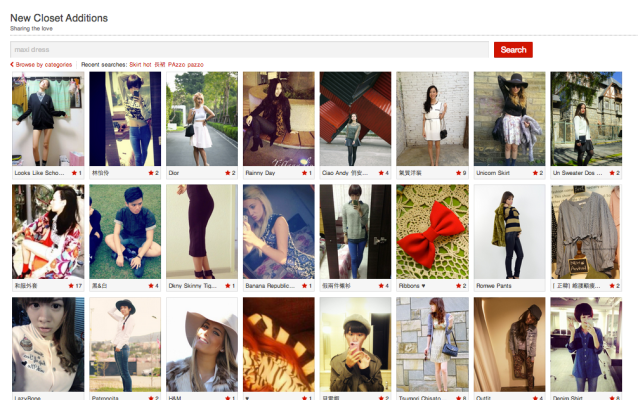Remember Plurk, the social network once considered a rival to Twitter, along with other microblogging sites like Heello, FriendFeed and the late Rejaw? Plurk is still trucking along with 10 million users (and recent funding from W.I. Harper) and now its founder, Alvin Woon, is working on Re.mu, his new fashion-based startup.
Re.mu is a mobile- and web-based social network that is targeted at the kind of style lover who would rather browse thrift stores and Etsy than covet high-end designer items. Woon says he wanted to create a site that would attract users who are already showing off their daily outfits on platforms like Instagram. Re.mu’s seed investors include Taipei-based TMI Holdings and KAMIA.
For its users, Re.mu combines the functions of clothing organizing apps such as Closet, NetRobe and Stylitics with a social platform that lets people share their daily outfits, get validation from other users with similar tastes, and go shopping in-app. Re.mu’s community is still small — since launching two months ago, it has racked up 35,000 users — but Woon says the community is highly engaged and uploads about 25,000 posts per day, including photos of outfits and items that they own.
In addition to Asia, Re.mu is also targeting growth in Spanish-speaking countries and the U.S. Re.mu can offer analytics about trends emerging in those places for fashion companies. For example, one trend that Re.mu has picked up on over the last two months is the popularity of floral-print leggings in Korea, China, Taiwan, Japan and Thailand. Seventy percent of users in those countries, however, prefer to dress in black, white or grey, and Woon is excited about the potential of Re.mu’s data for social scientists that see fashion trends as an economic indicator.
But Re.mu has plenty of competition. Lookbook.nu is already well-established among fashion brands as a source for trend forecasting. Other fashion communities include Chictopia, StyleMob, Pose and Tagbrand, as well as the many style blogs on Tumblr and wardrobe_remix, a long-running group on Flickr.
Woon says Re.mu sets itself apart with features like a machine-learning algorithm that will tell you how to style pieces you already own, based on factors like your favorite color combinations, body type and what’s trendy in your area. The site also offers “very granular filtering” in order to give companies and designers insight into not only what items are popular each season, but how fashion consumers are styling them.
Re.mu also wants to differentiate with an approach to fashion that encourages people to wear the stuff they already own instead of chasing the latest products. To build traction, Re.mu has been targeting consumers who share that philosophy.
In the U.S. and Spanish-speaking countries, the startup has approached bloggers who are into searching thrift shops for secondhand items or buying handmade items on Etsy. That tactic doesn’t work as well in Asia, where many style-conscious consumers still covet luxury brands like Louis Vuitton and Chanel, but Re.mu has stuck to its idealism. In Taiwan, for example, the startup has hosted secondhand clothing markets.
Of course, Re.mu will have to balance its “spend less and wear what you have” manifesto with the demands of fashion brands as it develops its business strategy, which Woon admits will be a delicate balancing act. He faced the same challenge at Plurk.
“I think after a while, I began to realize that I’m good at building communities, but maybe not that good at trying to make money out of them,” he says. “But I’m pretty good at building stuff and getting people to come and play with it.”
Re.mu’s path to monetization is more clear-cut than Plurk’s because it already has a strong vertical. Right now the app has affiliate links to e-commerce sites like Saks.com. Woon says he wants Re.mu to eventually offer whole catalogs inside the app from a select roster of brands, with a focus on independent designers. To encourage users to make purchases in-app, Re.mu will offer incentives like discounts or the ability to upload more photos with each post.
Plurk never achieved the high profile of Twitter and the microblogging networks of Sina and Tencent, both of which are massively popular in China, but Woon says that its traffic has continued to grow steadily since its launch in 2007. Woon isn’t involved with its day-to-day operations anymore, but he’s still its chairman.
Though it’s hard to recall in the wake of Twitter’s successful IPO, the site once had masses of users threatening to leave because of its server problems. The irritatingly frequent appearance of Twitter’s Fail Whale error message helped cast Plurk and other microblogging sites as strong rivals.
When I asked Woon if it’s weird to see Plurk described as a Twitter also-ran, he was frank.
“Plurk is a six-year-old company and I think we can agree that at times we lost track of what we were trying to do because people were trying to go for bigger targets, like how many millions or billions of users we could have,” he says.
Now Plurk focuses on attracting users who want to connect with small social circles over niche topics they are passionate about (Woon has described Plurk’s average user as “16-28. Female. Cos-player. Knitter. Second Lifer. Likes cheesecake.”)
Woon hopes Re.mu will retain that same sense of intimacy even as its user base grows.
“It’s a matter of trying to create a medium where newcomers don’t feel left out when they first get a taste of the network. Then after a while, you need something to keep them hooked,” he says. “As their friends join, are they going to get the feeling, like, if you like an indie band and then it gets popular and then you start not to like them anymore because now even your mom knows about them? We want to preserve a tight-knit social network as we grow.”
